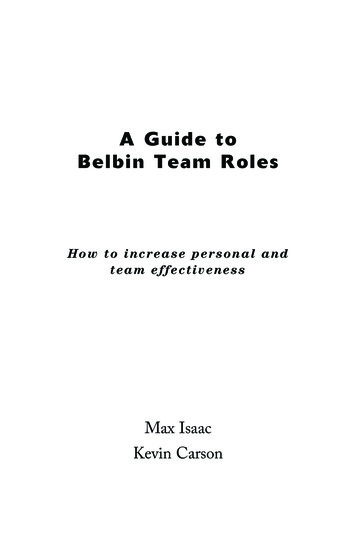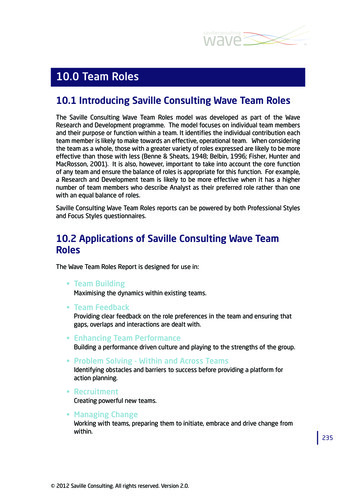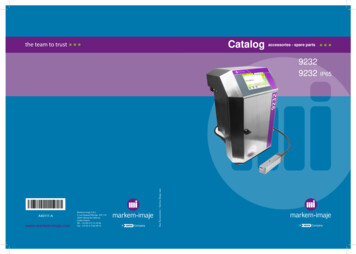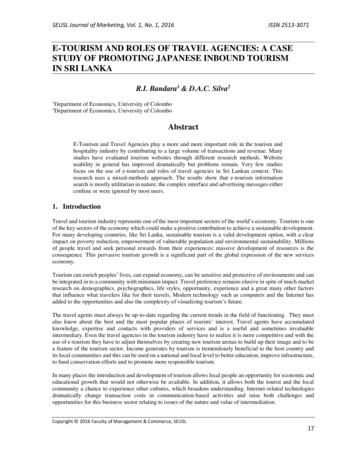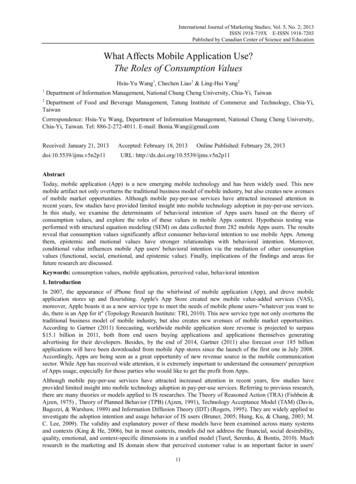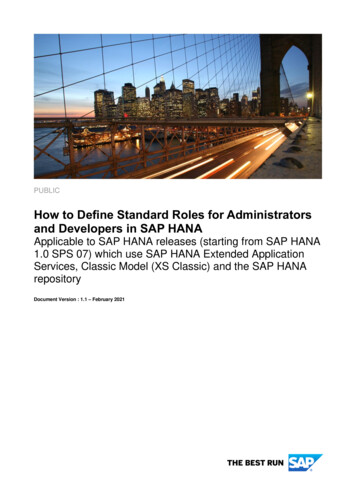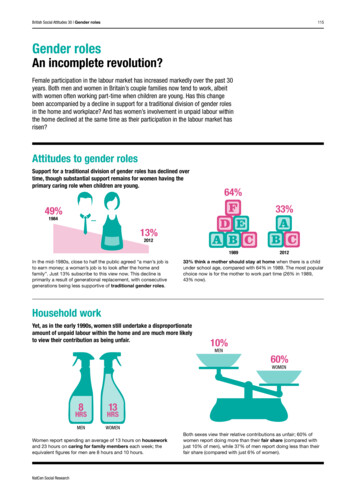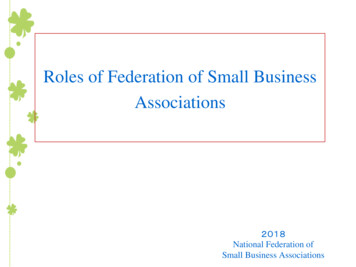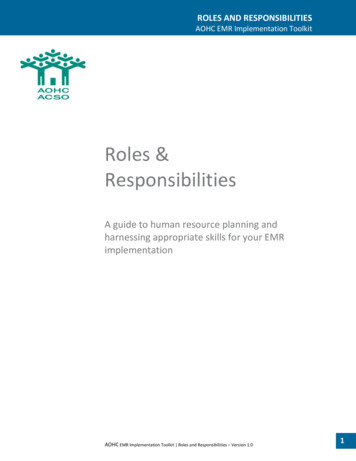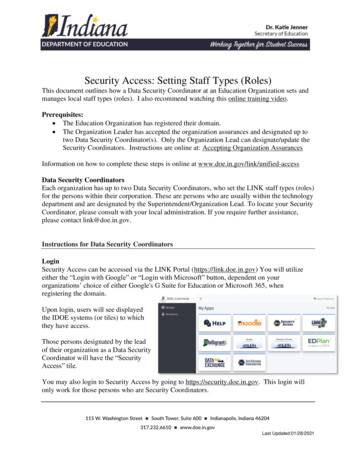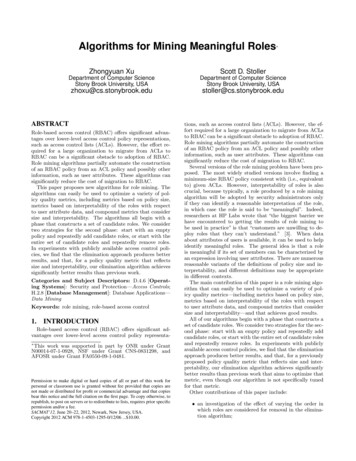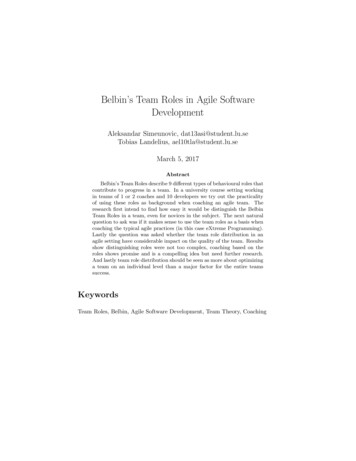
Transcription
Belbin’s Team Roles in Agile SoftwareDevelopmentAleksandar Simeunovic, dat13asi@student.lu.seTobias Landelius, ael10tla@student.lu.seMarch 5, 2017AbstractBelbin’s Team Roles describe 9 different types of behavioural roles thatcontribute to progress in a team. In a university course setting workingin teams of 1 or 2 coaches and 10 developers we try out the practicalityof using these roles as background when coaching an agile team. Theresearch first intend to find how easy it would be distinguish the BelbinTeam Roles in a team, even for novices in the subject. The next naturalquestion to ask was if it makes sense to use the team roles as a basis whencoaching the typical agile practices (in this case eXtreme Programming).Lastly the question was asked whether the team role distribution in anagile setting have considerable impact on the quality of the team. Resultsshow distinguishing roles were not too complex, coaching based on theroles shows promise and is a compelling idea but need further research.And lastly team role distribution should be seen as more about optimizinga team on an individual level than a major factor for the entire teamssuccess.KeywordsTeam Roles, Belbin, Agile Software Development, Team Theory, Coaching
1IntroductionOne of the major differences between agile development and traditional waterfalldevelopment is that in agile development there are no or much less explicit roleassignment in an agile setting. Often planning, architecture, programming,testing etc is done by everyone in the team. But there is no way to avoid thefact that people by nature take different roles when working in a team. Thisleads to questions about how each persons behaviour effect the success in anagile team. And if there is more awareness about the roles, especially fromcoaches or managers, can we use this knowledge to maximize the success. Toquantify roles during this research Belbin’s 9 team roles were used [1]. Theseroles reflect how a person will interact and contribute to a team and accordingto Belbin it is seen as optimal to have all 9 represented in a team.In our study we will try to investigate how hard it is to distinguish these 9roles in team members by observation. If the knowledge of what roles are in ateam can be of use when coaching an agile team towards success. We will alsolook into if the composition of team members can be seen as a major factor forsuccess. Do we need all 9 roles?2BackgroundThis section provides the necessary background information for the report. Section 2.1 further describes Belbin’s nine team roles. Their context and also thequalities of each role. This is knowledge we deem necessary to be aware ofand to be able to properly follow the result and discussion parts of the paper.Section 2.2 then describes the context of the research, the course setting andproject layout.2.1Belbin’s Team RolesTo analyze a team based on the composition of team roles there was a needfor recognizing and categorizing the team role qualities of each individual teammember. For this project the theory used was the well known nine team rolesof Belbin [1]. These roles where produced by Belbin in rigorous research byobserving teams and their success. 9 different roles where encountered as thespecific types of roles that are needed for a well functioning team. The teamroles work as a framework for the roles a person tend to take in a team and canbe used to generalize their strengths and weaknesses. There are 9 roles in totalwhich can be divided into 3 subgroups: Action, People and Thinking, describedin sections 2.1.1, 2.1.2 and 2.1.3. The team roles are not to be seen as the sameas personality, personality is rather one of many factors that effect a personsbehaviour.1
The team roles can be used on an individual, group, or company level to getthe most out of people’s strength and be aware of their weaknesses. [1]Following sections, 2.1.1 to 2.1.3, briefly describe each role. A more detailedtable with strengths and weaknesses for each role can be found in appendix A.2.1.1Belbin’s Team Roles: Action-categoryThe action category consist of people primarily contributing to a team by doing.They all have a way to get work done but does it a little different.Completer/Finisher: The Completer/Finisher is one of the three roles inthe action-category. A Completer takes action and works towards perfection.Implementer: Second in the action-category is the Implementer role. As thename suggest an Implementer is great at planning ahead andgetting work done,which is why this role used to be called ”Company-Worker”, but changed dueto negative connotations.Shaper: Lastly in the action-category is the Shaper. In contrast to the Implementer a Shaper is more dynamic and does less forward planning.2.1.2Belbin’s Team Roles: People-categoryTeam members with primary roles in the people-category has the ability to succeed by not only taking action themselves, but also in different ways lifting andbringing forth greatness in others.Coordinator: Coordinators are the delegating type of role in the peoplecategory. Coordinators are great at pinpointing the key objectives for its teamand recognizing how to divide work efficiently.Resource Investigator: Second type in the people-category is Resource Investigator. Typical for this role is an energetic drive to find new ideas and solutionsthe team needs for progress.Teamworker: The third people-category role is the classical Team Worker.As the name suggest they are great at working with others, creating a workingenvironment with focus on the team cooperative to finish required tasks.2.1.3Belbin’s Team Roles: Thinking-categoryThe thinking category consist of roles that first and foremost uses their cognitiveabilities to contribute to the team. Whether it being analyzing current state,thinking of new possibilities or having specialist knowledge in a certain area.2
Monitor Evaluator: Finally there is the thinking-category of team roles, firstcontaining the Monitor Evaluator. As the name suggests this is a role that tendto monitor the progress of the team and then evaluate the results in a critical,impartial way.Plant: A Plant uses it’s thinking abilities to solve problems highly effectivelybut less thoughtful with less concern for the bigger picture than a MonitorEvaluator.Specialist: The last of the 9 roles is the Specialist. This role is simply a personwith a special set of skills which they contribute to the team.2.2ContextThis paper is written as an in-depth study part of the course Coaching of programming teams (EDA270) at Lund University. The first half of this coursecontained seminars of various coaching topics and prepared aspiring coacheswith theoretical understanding. The second part of the course consisted of 6weeks of coaching an actual team of developers. The developers were other engineering student taking the course ”Software Development in teams” which isa course given in parallel with the coaching course and aims to teach studentsthe agile practices of developing software in teams. In the course the team shallproduce a fairly simple timekeeping program but the main focus is to work inan agile setting using eXtreme Programming (XP). Each team consists of oneor two coaches and usually 10 developers. The project included one 2 hourintroduction meeting followed by 6 iterations of development. Each iterationhad a 2 hour planning game/retrospective session and an 8 hour workday ofdevelopment. This provided a good setting to test hypothesis about team rolesand the time to analyze. Their was also opportunity to include other teams inthe course to try out our research questions on a larger sample size. To get moredetailed information about the course setup read the paper ”Teaching extremeprogramming to large groups of students” [2] by Bendix, Magnusson and Hedin.3MethodThis section contains research questions, why we choose them and also a description of the research method for each question. Section 3.4 is the basis forall the different research questions.3.1Distinguish Team Roles Research Question 1: How difficult is it to distinguish team roles withina team by observation?3
The question of distinguishing team roles is the core foundation for our research.It is quite clear that when distinguishing team roles within a team requiresexperience and practice. Experienced people that have worked in several teamswill begin to see patterns around team role behaviour. The interesting questionis if a novice coach can distinguish roles at such success that the result becomesuseful. Our research method was that during the first three iterations of theproject we observed the team and then tried to figure out which team roles wehad based on Belbin’s theory. The team were then given the team role test andthe outcome of this was compared to our predictions.3.2Using team roles when coaching Research Question 2: Can the knowledge of team roles easily be usedactively when coaching an agile team?When the team roles within the team were set based on Belbin team role testand from our observations we then wanted to use this knowledge as a basis forcoaching with the agile principles. The goal and purpose of doing this is to seewhether a coach could optimize the different moments within the agile processand some areas that we were focusing on was: Pair programming: Can knowledge of the roles be used to assembleeffective pairs. Release: Would a Completer Finisher be fit to getting the program readyfor release?Other areas that this knowledge could prove to be useful could be for examplethe planning game and when delegating spikes. You could with this knowledgemanipulate it in many more ways but since we had only six weeks, we wheretrying to focus on some areas.3.3Team role distribution Research Question 3: Does the success of the project depend on havingall 9 roles?As Belbin claims all roles are crucial for a well working team. We wanted tolook into if the distribution of roles in a team would in a evident way effect theresult in our course setting. Therefore we made use of all ten teams and by twoquestionnaires collected the following data: To developers the Belbin team role test to find out how the roles weredistributed between the developers in each team. To coaches how well the team did in 5 different aspects:– Stories completed4
– Cohesiveness– Communication– Ambition– Problem solving skillsThe 5 aspects that were given to the coaches in the questionnaire was elicitedwith the team roles as basis for getting metrics and are all interesting areasrelated to XP. These result of this is shown in section 4.2 and our hypothesiswere that if the team scored lower in some team roles they might be doing worsein all or some part of there work related to the strength of the missing role.3.4Belbin team role testThis section describes the Belbin team role test referred to throughout the paper.This particular test was created by an independent company for personality andIQ tests and consists of 40 questions were each question is a choice between twopersonality traits [3]. The results of a test shows what percentage of each rolethe developer has. An example of the test output is show in figure 1. Theexample in this case has the primary role as an Implementer and the weakestas a Coordinator.Figure 1: Example output result from a Belbin team role test. Showing themembers scoring as a percentage for each role.4ResultThis sections contains the data collected during the research for research questions 1 and 3. For question 2 the data collected was hard to interpret / inconclusive therefore that result is not published. There is still some discussionabout question 2 in section 5.2.5
4.1Distinguishing team rolesFigure 2 shows our assumptions of the team roles compared to the results of theBelbin test. Both assumptions and test results roles are shown in descendingorder for each member (the topmost one being the members most dominantrole).Figure 2: Team role assumptions versus Belbin’s test results4.2Team role distributionThis section contains three figures where the first figure shows the team roledistribution for all ten teams. As described in section 3.4 the Belbin team roletest gave us a score for each role as a percentage. Figure 3 shows the averagescore for the entire team across all 10 teams.6
Figure 4 shows the scoring of the three different subgroups that we mentionedin section 2.1, thinking, people and action.Finally, figure 5 shows two different things, first it shows the results from thethe other teams coaches which is about team competence ranked on a scale from1 to 10 based on the subjective impression they have on the team. Second, itshows how many story points each team has completed, a metric for the progressfor each team.Figure 3: Scoring of Belbin team roles across all 10 teamsFigure 4: Scoring of subgroups across all 10 teams7
Figure 5: Team competence ranked from 1 to 10 based on subjective opinion ofcoaches. As well as story points done5DiscussionThis section contains discussions about the results presented in the sectionabove. Section 5.1 and 5.3 discusses the result shown in previous section. Eventhough the result from how we can use roles were inconclusive we still discussedthis in section 5.2.5.1Distinguishing team rolesAs seen in Figure 2 we got a pretty good accuracy of what we thought were theteam members different roles based on our observations in correspondents tothe results we got from the test we made them take. To judge them by differentroles we needed knowledge about the theory and about how all roles behave.Another factor that is crucial for a more accurate estimation is time, we tookthree iterations to get a feel for roles in the team before we discussed themamongst ourselves and did our estimations.In most of the team members we predicted at least one dominant role right.A few we managed to predict perfectly. A clear anomaly in the result is TeamMember 10 where our assumption
To developers the Belbin team role test to nd out how the roles were distributed between the developers in each team. To coaches how well the team did in 5 di erent aspects: { Stories completed 4 { Cohesiveness { Communication { Ambition { Problem solving skills The 5 aspects that were given to the coaches in the questionnaire was elicited with the team roles as basis for getting metrics and .
